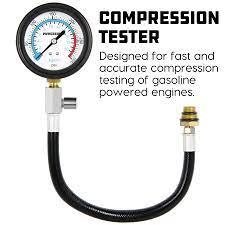
How to Properly Use a PowerSports Compression Tester
Q9powersportsusa.com StaffShare
Introduction
When it comes to maintaining and diagnosing issues with your PowerSports vehicle's engine, a compression tester is an essential tool. By measuring the compression pressure in each cylinder, you can identify potential problems and take timely action to keep your engine running smoothly. In this article, we will guide you on how to properly use a PowerSports compression tester.
Step 1: Gather the Necessary Tools
Before you begin, make sure you have all the required tools and equipment. You will need:
- A PowerSports compression tester kit
- A spark plug socket and ratchet
- A wrench or pliers
- A pen and paper to record the readings
Step 2: Prepare Your PowerSports Vehicle
Prior to performing a compression test, ensure that your vehicle is in a safe and well-ventilated area. Follow these steps to prepare your vehicle:
- Turn off the engine and let it cool down completely.
- Remove any obstructions around the engine, such as covers or panels.
- Locate the spark plugs and carefully remove them using a spark plug socket and ratchet.
Step 3: Connect the Compression Tester
Now, it's time to connect the compression tester to your PowerSports vehicle:
- Locate the spark plug hole for the first cylinder.
- Attach the compression tester's hose to the spark plug hole.
- Tighten the connection using a wrench or pliers to ensure a secure fit.
Step 4: Perform the Compression Test
With everything properly connected, you can now conduct the compression test:
- Hold the throttle wide open to allow maximum airflow.
- Ask a friend to assist you by turning the ignition key to start the engine.
- Observe the compression gauge as the engine turns over. Note the highest reading achieved.
- Repeat this process for each cylinder, following the same steps.
Step 5: Analyze the Results
Once you have completed the compression test for all cylinders, it's time to analyze the results:
- Compare the readings obtained with the manufacturer's specifications for your PowerSports vehicle.
- If all cylinders' compression values are within the acceptable range, your engine is in good condition.
- If any cylinder shows significantly lower compression, there may be an issue with that cylinder, such as a worn piston ring or a leaking valve.
Troubleshooting Common Compression Test Issues
While performing a compression test, you may encounter certain issues. Here are some common problems and their solutions:
Low Compression Readings
If you obtain consistently low compression readings across all cylinders, it may indicate a more significant issue with the engine. Possible causes include worn piston rings, damaged cylinder walls, or a blown head gasket. Consult a professional mechanic for further diagnosis and repair.
Inconsistent Readings
If you notice significant variations in compression readings between cylinders, it could indicate an issue with the valves or valve seats. This can result in poor sealing and reduced compression. Seek professional assistance to inspect and rectify the valve-related problems.
No Compression
If the compression gauge shows zero compression across all cylinders, it usually signifies a broken timing belt or chain. In such cases, the valves may not be opening and closing properly, leading to no compression. Immediate repair is necessary to avoid extensive engine damage.
Maintaining Your PowerSports Compression Tester
To ensure accurate and reliable compression readings, it's essential to maintain your PowerSports compression tester:
- Store the compression tester in a clean and dry place to prevent any damage or contamination.
- Regularly check the hose and fittings for any signs of wear or leaks. Replace any damaged components promptly.
- Calibrate your compression tester periodically as per the manufacturer's instructions or recommendations.
Conclusion
Using a PowerSports compression tester is a crucial step in diagnosing engine problems and ensuring the optimal performance of your vehicle. By following the steps outlined in this article, you can confidently and accurately perform a compression test on your PowerSports engine. Remember, regular maintenance and timely identification of issues can help prevent costly repairs and keep your PowerSports vehicle running smoothly for years to come. Invest in a reliable compression tester, gather the necessary tools, and take control of your engine's health today!
